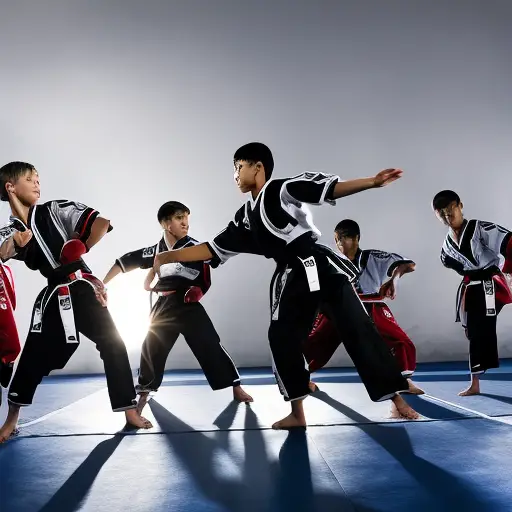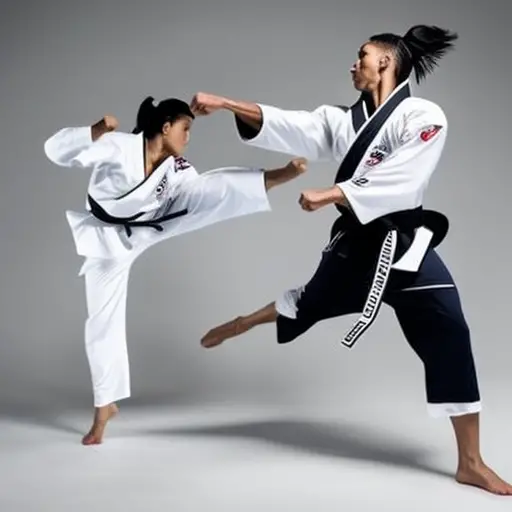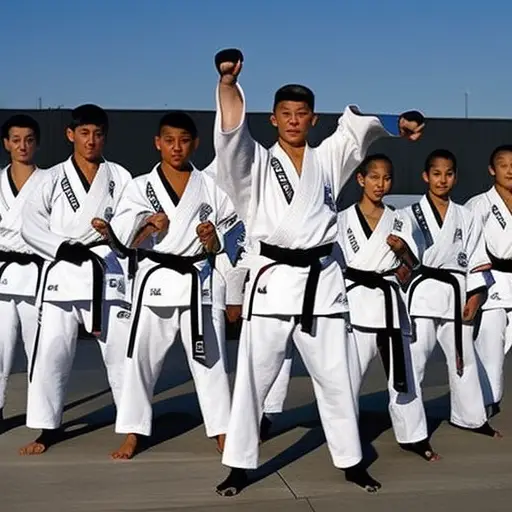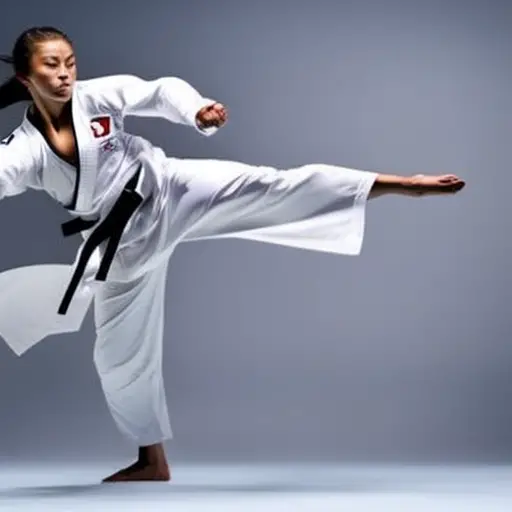Taekwondo for Athletes in Other Sports: Complementary Training

Discover the hidden potential within athletes by integrating the power of Taekwondo into their training regimen. Taekwondo, renowned for its dynamic kicks and explosive movements, offers a unique set of benefits that can complement and enhance performance in other sports.
From improving flexibility and mobility to developing explosive power and speed, this ancient martial art provides athletes with the edge they need to excel.
In this article, we delve into the strategies and techniques of Taekwondo, providing invaluable insights for athletes seeking to elevate their game.
The Benefits of Taekwondo for Athletes
One of the key benefits of practicing taekwondo for athletes is that it can significantly improve their overall physical fitness and mental well-being. Taekwondo is a martial art that combines various elements of self-defense techniques, physical conditioning, and mental discipline.
Athletes who incorporate taekwondo training into their regimen can experience enhanced endurance and mental toughness. Endurance is a crucial aspect of any athlete’s performance. Taekwondo training involves rigorous cardiovascular exercises, such as high-intensity kicks, punches, and footwork drills. These activities increase the heart rate and improve the body’s ability to efficiently deliver oxygen to the muscles. As a result, athletes who practice taekwondo can develop greater stamina and endurance, allowing them to perform at higher levels for longer durations.
In addition to physical benefits, taekwondo also promotes mental toughness. The art form requires intense focus, discipline, and perseverance. Athletes who train in taekwondo learn to overcome challenges, push their limits, and stay determined even in the face of adversity. This mental fortitude translates into other sports, enabling athletes to maintain composure, handle pressure, and overcome obstacles.
Enhancing Flexibility and Mobility Through Taekwondo
Enhancing flexibility and mobility through Taekwondo can lead to improved athletic performance, injury prevention, and faster recovery.
By incorporating stretching exercises, dynamic movements, and kicking techniques, athletes can increase their range of motion, allowing them to move more efficiently and effectively in their respective sports.
Additionally, the emphasis on proper technique and body control in Taekwondo helps athletes develop better body awareness and balance, reducing the risk of injuries.
Improved Athletic Performance
By incorporating Taekwondo into their training regimen, athletes from other sports can experience improved athletic performance through enhanced flexibility and mobility. Taekwondo training involves dynamic movements and stretches that target various muscle groups, leading to increased range of motion and improved flexibility. This increased flexibility allows athletes to perform their sport-specific movements with greater efficiency and reduced risk of injury.
Additionally, Taekwondo incorporates agility training, which focuses on quick movements, changes in direction, and coordination. This type of training can greatly enhance an athlete’s agility, balance, and reaction time, all of which are crucial for improved performance in sports.
By incorporating Taekwondo into their training routine, athletes can improve their endurance, agility, and overall athletic performance. This enhanced performance can translate to better results in their respective sports.
Moreover, the flexibility and mobility gained through Taekwondo can also aid in injury prevention and recovery, which will be discussed in the subsequent section.
Injury Prevention and Recovery
Taekwondo training can significantly improve an athlete’s flexibility and mobility, aiding in injury prevention and recovery. By incorporating taekwondo techniques into their training regimen, athletes can enhance their range of motion, joint stability, and overall body control. This increased flexibility and mobility can help prevent common injuries such as strains, sprains, and muscle imbalances.
Moreover, taekwondo offers various rehabilitation techniques that can assist in the recovery process from injuries. These techniques include stretching exercises, balance drills, and controlled movements that promote healing and strengthen the affected areas. Additionally, taekwondo emphasizes proper body alignment and posture, which can reduce the risk of injury by improving body mechanics during athletic movements.
To illustrate the benefits of taekwondo for injury prevention and recovery, the following table highlights some key flexibility and mobility exercises commonly practiced in taekwondo:
| Exercise | Target Area | Benefits |
|---|---|---|
| Front Leg Stretch | Hamstrings | Increases flexibility in the lower body |
| Hip Rotations | Hips | Enhances hip mobility and stability |
| Back Kicks | Lower back | Strengthens lower back muscles |
| Side Lunges | Groin muscles | Improves groin flexibility and strength |
| Rotational Stretches | Spine | Increases spinal mobility and flexibility |
Incorporating these exercises into an athlete’s training routine can help prevent injuries and promote a faster recovery process. By focusing on flexibility and mobility through taekwondo, athletes can optimize their performance and reduce the likelihood of setbacks due to injuries.
Transitioning into the subsequent section about ‘developing explosive power and speed with taekwondo’, athletes can leverage their improved flexibility and mobility to maximize their training and enhance their overall athletic abilities.
Developing Explosive Power and Speed With Taekwondo
Athletes can effectively improve their explosive power and speed by regularly incorporating taekwondo training into their workout routines. Taekwondo, a martial art that emphasizes agility, flexibility, and speed, offers specific techniques and training methods that can enhance an athlete’s explosive power and speed.
Here are three ways taekwondo can help athletes develop explosive power and speed:
-
Plyometric exercises: Taekwondo incorporates various plyometric exercises such as jump kicks, explosive jumps, and rapid directional changes. These exercises focus on generating maximum force in a short amount of time, improving explosive power and speed.
-
High-intensity interval training (HIIT): Taekwondo training often involves intense bursts of activity followed by short rest periods. This type of interval training improves cardiovascular endurance, enhances fast-twitch muscle fibers, and boosts overall speed and explosiveness.
-
Reaction drills: Taekwondo practitioners engage in partner drills that require quick reactions and rapid movements. By practicing these drills, athletes can develop their reflexes, agility, and explosiveness, leading to improved speed and power on the field or court.
Incorporating taekwondo into their training regimen can be a valuable asset for athletes seeking to enhance their explosive power and speed. By utilizing plyometric exercises, high-intensity interval training, and reaction drills, athletes can take advantage of taekwondo’s unique training methods to elevate their athletic performance.
Improving Balance and Coordination for Athletes
Improving balance and coordination are essential for athletes in any sport as they can greatly enhance athletic performance and reduce the risk of injuries.
Through practicing taekwondo, athletes can develop a strong sense of balance and coordination, which can translate into improved agility, stability, and body control.
Enhancing Athletic Performance
To enhance athletic performance, athletes can focus on developing their balance and coordination through complementary training methods. Here are three sport-specific training techniques that can help improve these areas:
-
Taekwondo: Practicing taekwondo can significantly enhance balance and coordination, as it involves precise movements and quick transitions between stances. The kicks, punches, and blocks performed in taekwondo require athletes to maintain stability and control over their bodies, which translates to improved balance and coordination in other sports.
-
Plyometric exercises: Plyometric exercises, such as box jumps and lateral hops, can improve explosive power and coordination. These exercises involve quick, forceful movements that require athletes to efficiently transfer energy from their muscles to their movements, ultimately enhancing overall athletic performance.
-
Balance training equipment: Utilizing balance training equipment, such as stability balls and balance boards, can challenge athletes to improve their stability and coordination. These tools force athletes to engage their core muscles and focus on maintaining balance, leading to better overall body control and performance in their respective sports.
By incorporating these training techniques into their routines, athletes can enhance their balance and coordination, ultimately improving their athletic performance.
Transitioning into the subsequent section about injury prevention techniques, it is important for athletes to also focus on minimizing the risk of injuries during training and competition.
Injury Prevention Techniques
By implementing specific injury prevention techniques and focusing on improving balance and coordination, athletes can significantly reduce the risk of injuries during training and competition. Preventing common injuries is crucial for athletes in order to maintain their performance and overall well-being.
Taekwondo offers various exercises and drills that can help strengthen weak areas and improve balance and coordination. These techniques involve practicing stances, kicks, and strikes, which require athletes to engage their core muscles and maintain proper body alignment. Additionally, incorporating balance training exercises, such as standing on one leg or performing balance board exercises, can further enhance stability and prevent falls or missteps. By consistently practicing these injury prevention techniques, athletes can improve their overall physical readiness and minimize the risk of injuries.
Transitioning into the subsequent section on mental discipline and focus, developing these skills is equally important for achieving sports success.
Mental Discipline and Focus: The Key to Sports Success
Enhancing athletes’ cognitive abilities is paramount to achieving peak performance in sports. Mental discipline and focus play a crucial role in an athlete’s success on the field. The ability to maintain concentration amidst distractions and pressure can make all the difference in competitive sports.
Here are three key aspects of mental discipline and focus training that can help athletes develop their mental toughness:
-
Visualization: Visualization techniques involve creating vivid mental images of successful performances. Athletes can use this technique to imagine themselves executing flawless movements, scoring goals, or hitting the perfect shot. By repeatedly visualizing success, athletes develop a strong belief in their abilities and enhance their focus during actual competitions.
-
Mindfulness: Mindfulness training teaches athletes to stay present in the moment and be fully aware of their thoughts, emotions, and bodily sensations. By practicing mindfulness, athletes can improve their ability to stay focused, manage stress, and make better decisions under pressure.
-
Goal Setting: Setting clear and specific goals is crucial for maintaining focus and motivation. Athletes can break down their long-term goals into smaller, achievable targets. By setting measurable goals, athletes can track their progress and stay committed to their training, leading to improved mental discipline.
Strategies and Techniques From Taekwondo for Athletes
Implementing the principles of taekwondo alongside their existing training regimens, athletes can effectively incorporate strategies and techniques to enhance their performance in other sports. Taekwondo offers a range of strategies and techniques that can be adapted and utilized by athletes to gain an edge in their respective disciplines.
One of the key strategies in taekwondo is agility and footwork. Athletes can benefit from incorporating taekwondo footwork drills into their training routines, enhancing their speed, balance, and coordination. These drills focus on quick and precise movements, enabling athletes to react swiftly to changing situations in their sports.
Another technique that can be borrowed from taekwondo is the use of kicks. Kicks in taekwondo are powerful and dynamic, requiring strength, flexibility, and accuracy. Athletes can adopt and modify these kicking techniques to suit their specific sports, whether it is soccer, martial arts, or basketball. Kicking can provide an additional weapon in their arsenal, allowing for more versatile attacking and defensive maneuvers.
Furthermore, taekwondo emphasizes mental focus and discipline. Athletes can benefit from incorporating mindfulness and concentration techniques into their training routines. This can help them stay calm under pressure, make quick decisions, and maintain focus during intense competitions.
Incorporating Taekwondo Into Your Training Routine
Integrating taekwondo into an athlete’s training routine can provide a valuable addition to their overall physical and mental development. Taekwondo techniques can be incorporated into various sports training programs, offering a range of benefits for athletes across different disciplines.
Here are three ways in which taekwondo can be integrated into training routines:
-
Taekwondo as cross training for endurance athletes: Endurance athletes, such as runners or cyclists, can benefit from the explosive movements and dynamic techniques found in taekwondo. The high-intensity training sessions in taekwondo can improve cardiovascular endurance, agility, and flexibility, which are essential for performing well in endurance sports.
-
Integration of taekwondo techniques in team sports training: Team sports, like soccer or basketball, require a combination of physical strength, speed, coordination, and agility. Incorporating taekwondo techniques, such as kicking drills or footwork exercises, can enhance an athlete’s ability to move swiftly, improve balance, and deliver powerful strikes. These skills can be particularly useful for athletes in team sports who need to outmaneuver opponents and execute precise movements.
-
Mental focus and discipline: Taekwondo training emphasizes mental focus, discipline, and self-control. Integrating taekwondo into a training routine can help athletes develop mental toughness, concentration, and the ability to handle pressure effectively. These attributes can positively impact an athlete’s performance in any sport, enabling them to stay focused, make quick decisions, and maintain composure during intense competition.
Frequently Asked Questions
What Are Some Common Injuries That Can Occur in Taekwondo and How Can Athletes in Other Sports Prevent Them?
Preventing common taekwondo injuries is crucial for athletes in other sports. Taekwondo training can benefit them by improving flexibility, strength, and balance, which can help prevent injuries such as sprains, strains, and fractures.
Are There Any Age Restrictions or Limitations for Athletes in Other Sports Who Want to Start Practicing Taekwondo?
Athletes in other sports who wish to begin practicing taekwondo may encounter age restrictions or limitations based on their specific circumstances. However, engaging in taekwondo can offer numerous benefits for athletes of all ages.
How Long Does It Usually Take for Athletes in Other Sports to See Improvements in Their Performance After Incorporating Taekwondo Into Their Training Routine?
Athletes in other sports typically start seeing improvements in their performance after incorporating taekwondo into their training routine within a few months, depending on the training frequency and individual factors.
Can Taekwondo Training Help Athletes in Other Sports With Their Mental Resilience and Ability to Handle Pressure in Competitions?
Taekwondo training can enhance mental toughness and the ability to handle competition pressure for athletes in other sports. Through its emphasis on discipline and focus, taekwondo can help athletes develop resilience and perform at their best under high-pressure situations.
Are There Any Specific Taekwondo Techniques or Strategies That Are Particularly Beneficial for Athletes in Certain Sports, Such as Basketball or Soccer?
Taekwondo offers techniques and strategies that can enhance agility, focus, and reaction time for athletes in certain sports like basketball or soccer. These include footwork drills, sparring exercises, and mental training methods.
Conclusion
In conclusion, incorporating Taekwondo into an athlete’s training routine can offer a wide range of benefits. From enhancing flexibility and developing explosive power to improving balance and mental discipline, Taekwondo provides valuable skills that can complement performance in other sports.
Whether you are a professional athlete or a recreational sports enthusiast, the techniques and strategies from Taekwondo can help you excel in your chosen athletic endeavors.
So why not explore the world of Taekwondo and discover how it can enhance your overall athletic performance?





